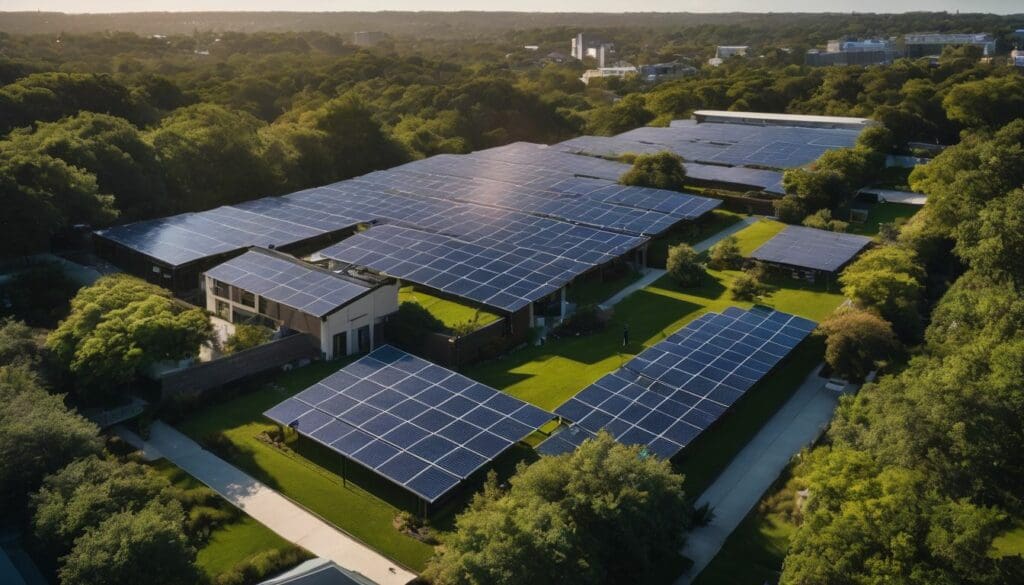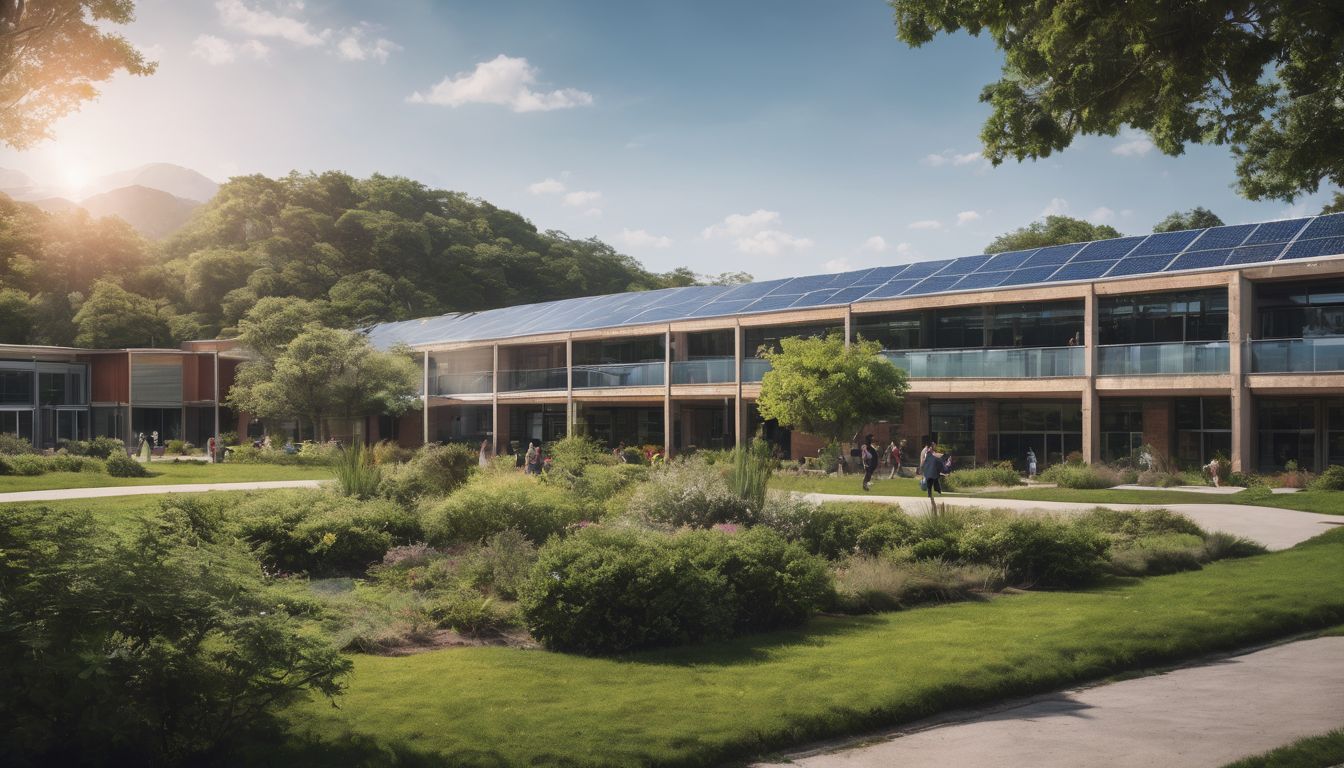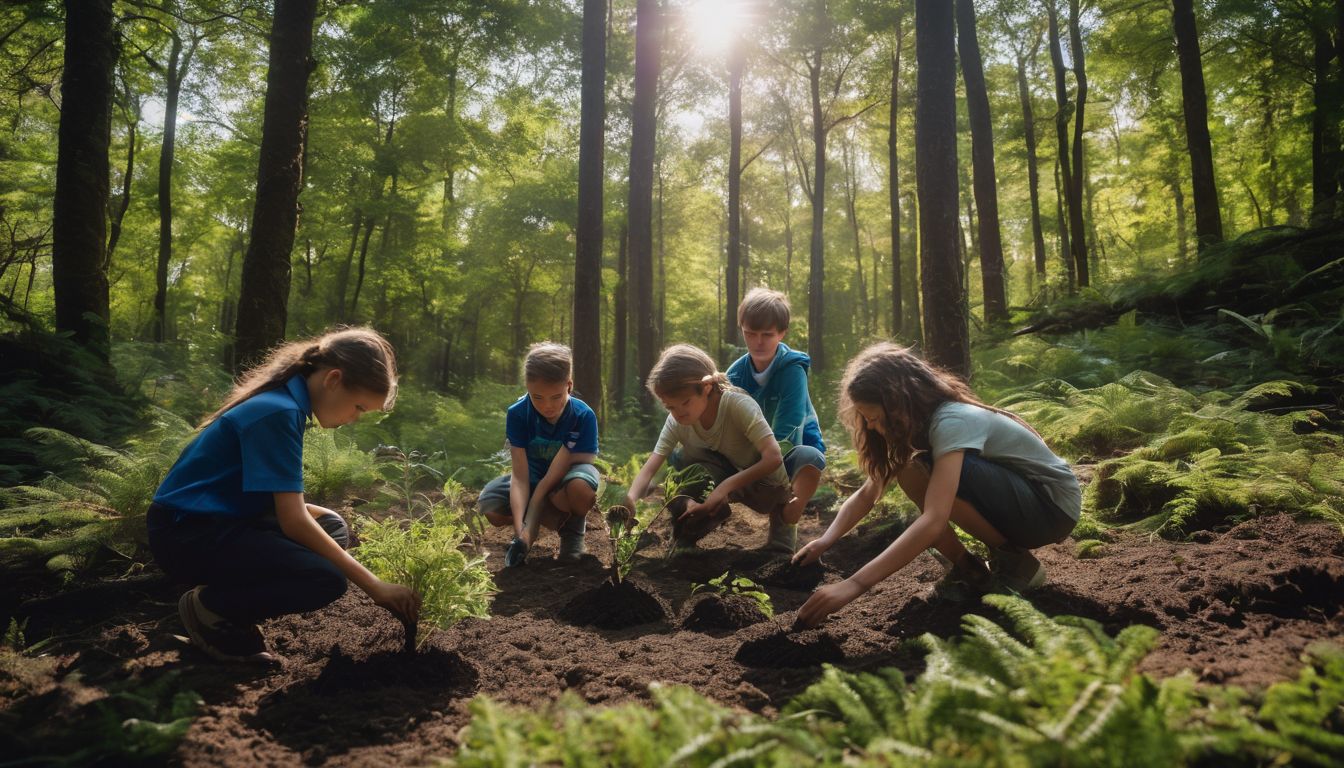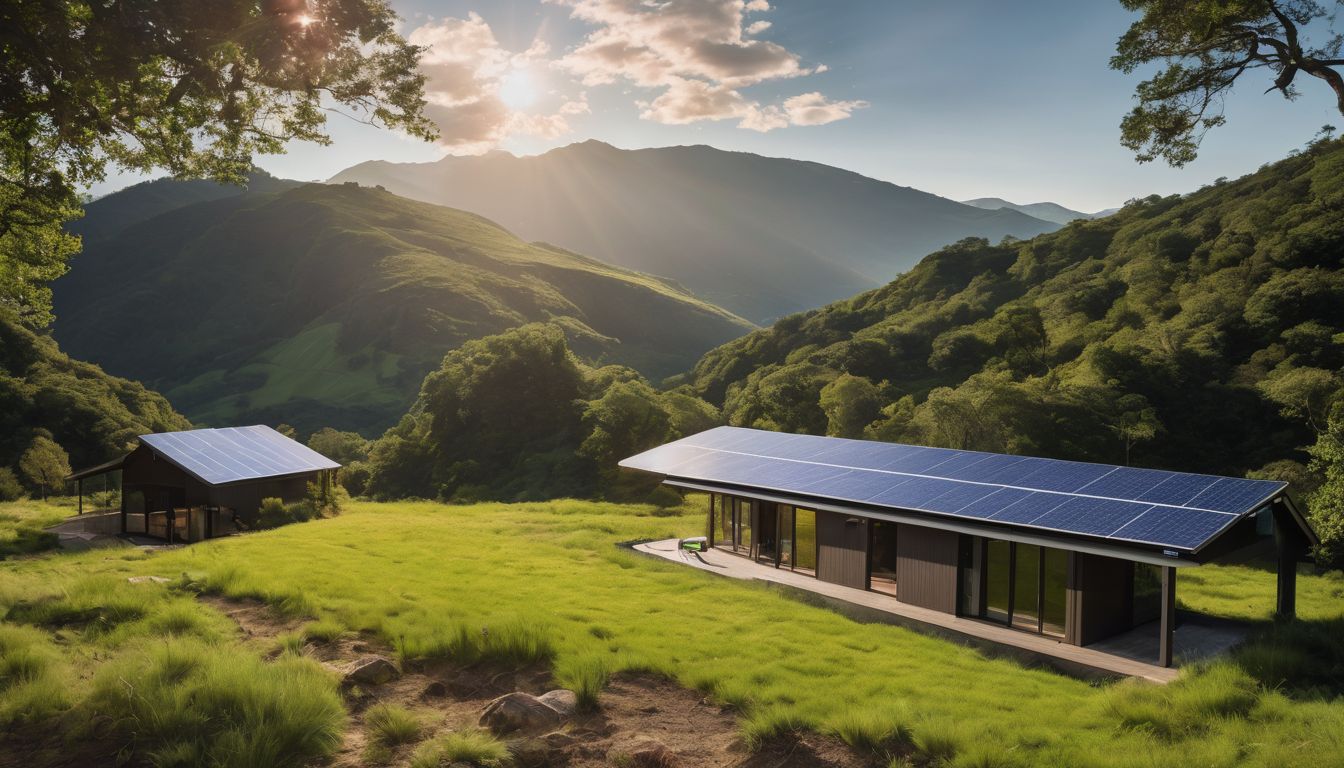Universities are key in shaping a sustainable future, but many still need to go green. In the UK alone, educational institutions have reduced carbon emissions by 47% since 2005. This blog will show you practical steps that universities can take to further embrace eco-friendly practices and principles.
Dive into sustainability at its academic best!
Key Takeaways
- Universities are reducing their carbon emissions, with UK educational institutions cutting back by 47% since 2005.
- Green practices in higher education include updating the curriculum to feature sustainability and engaging students in eco-friendly campus initiatives.
- Innovative funding models for green projects ensure investment in sustainable infrastructure and programs that align with environmental responsibility values.
- Active student involvement is key; hands – on sustainability initiatives enhance engagement and help retain a connection to the institution’s efforts.
- Digital technology reduces the environmental impact of higher education through online platforms, e – books, and interactive multimedia resources.
The Importance of Sustainability in Higher Education
Campus sustainability and environmental responsibility are crucial in higher education. Universities play a significant role in promoting sustainable development and preparing students for global challenges.
Campus sustainability and environmental responsibility
Universities are stepping up to the challenge of sustainability, integrating eco-friendly practices across their operations. They establish ambitious environmental goals, aiming for reduced waste and carbon footprints through green technologies and renewable energy sources.
Leaders in higher education recognise their unique position to mould sustainable mindsets by incorporating sustainability into curricula and modelling eco-conscious behaviours on campus.
Sustainable university practices go beyond energy-efficient buildings and recycling programs. Comprehensive initiatives engage both staff and students in conservation efforts, promoting a culture of environmental stewardship.
These institutions prioritise earth-friendly transportation options, climate-friendly procurement policies, and community outreach projects that underscore a commitment to protecting our planet for future generations.
The role of universities in sustainable development
To further advance sustainability efforts, universities play a pivotal role in advocating and implementing eco-friendly initiatives. These institutions serve as hubs for innovation, research, and knowledge dissemination on sustainable development.
By integrating green practices into their operations, curriculum, and community outreach programs, universities can foster a culture of environmental responsibility among students and faculty.
Embracing sustainable energy sources, reducing waste production, and promoting eco-friendly daily routines are some of the key ways through which universities contribute to global sustainability goals.
Incorporating these changes not only aligns with the principles of environmental sustainability in higher education but also equips students with practical skills and knowledge essential for addressing contemporary global challenges.
Strategies for Integrating Green Practices in Higher Education
Define your vision and goals to create a sustainable campus concept. Review and update the curriculum to include global perspectives on sustainability. Implement eco-friendly practices on campus, engage students in sustainability initiatives, and evaluate the impact of green practices for continuous improvement.
Define your vision and goals
Set clear objectives and a compelling vision that align with sustainable campus initiatives. Establish specific goals to reduce environmental impact, implement eco-friendly practices, and promote sustainability across the university community.
Incorporate green technologies in education while fostering a culture of environmental responsibility.
Develop a strategic plan that embraces global perspectives for higher education sustainability integration. Emphasise the importance of sustainable daily routines for college students, ensuring eco-friendly practices are deeply embedded within the institutional framework.
Review and update the curriculum
To incorporate green practices in higher education effectively, it is essential to review and update the curriculum regularly. By integrating sustainability-focused content into various courses, universities can cultivate a culture of environmental responsibility among students.
This involves revising existing modules to include topics such as sustainable development, climate change, and eco-friendly technologies. Furthermore, creating new courses dedicated to environmental studies or incorporating sustainability principles across disciplines can equip students with the knowledge and skills needed to address pressing global challenges.
In addition to this, revising the curriculum should involve promoting experiential learning opportunities related to sustainability, such as internships with environmental organisations or fieldwork focused on conservation efforts.
Implement sustainable practices on campus
Sustainable university practices can be implemented through various initiatives such as reducing energy consumption, promoting waste reduction, and advocating for eco-friendly transportation options.
Enhancing campus sustainability programmes and engaging students in environmental responsibility play a vital role in creating a greener academic environment. By evaluating the impact of these green initiatives, universities can foster a culture of conservation and contribute to climate-friendly practices on campus.
Engaging students in sustainability initiatives is essential for creating an environmentally responsible college community. Implementing sustainable daily routine practices for college students encourages earth-friendly behaviours and supports the overall mission of eco-friendly college campuses.
Engage students in sustainability initiatives
Involve students in sustainability projects on campus, providing them with opportunities to lead and participate in eco-friendly initiatives. Encourage their input for sustainable practices, fostering a sense of ownership and responsibility towards the environment.
Empower students through education and action, nurturing their passion for conservation while equipping them with practical skills to drive sustainable change within higher education institutions.
Evaluate the impact of green practices
Upon engaging students in sustainability initiatives, it’s crucial to evaluate the impact of green practices. By conducting regular assessments and monitoring key indicators such as energy consumption, waste diversion rates, and carbon emissions, universities can gauge the effectiveness of their eco-friendly efforts.
This data allows for informed decision-making and adjustments to sustainable strategies, fostering a culture of continuous improvement towards environmental responsibility in higher education.
Moreover, student involvement in these assessment processes not only enhances their understanding of sustainability issues but also cultivates a sense of ownership and accountability for the outcomes.
Trends and Challenges in Sustainable Higher Education
Some of the key trends and challenges in sustainable higher education include innovative funding models, enhancing student engagement and retention, leadership development and succession planning, addressing changing student demographics, and the impact of digital technology on higher education.
These factors all play a crucial role in shaping the future of eco-friendly practices within universities.
Innovative funding models
Higher education institutions are exploring innovative funding models to support their sustainability initiatives. These models involve partnerships with private companies, government grants, and community collaborations.
By seeking alternative sources of funding, universities can invest in eco-friendly infrastructure, research projects, and educational programs that promote environmental responsibility.
These new approaches to financing align with the values of environmentally conscious individuals who support conservation and sustainability efforts.
Enhancing student engagement and retention
To enhance student engagement and retention, universities can implement interactive and hands-on sustainability initiatives. Encouraging students to participate in eco-friendly projects, such as community clean-ups or campus garden programs, fosters a sense of ownership and responsibility for environmental conservation.
Additionally, incorporating sustainable practices into the curriculum through case studies and real-life examples creates meaningful learning experiences that resonate with environmentally conscious students.
By actively involving students in green practices, they develop a deeper understanding of environmental responsibility while feeling valued as contributors to the university’s sustainability efforts.
This not only enhances their educational experience but also increases their connection to the institution.
Leadership development and succession planning
Universities committed to sustainability need strong leaders who champion green practices and guide the institution towards a more eco-friendly future. Leadership development programs can nurture individuals to lead sustainable initiatives, ensuring continuity and progress in environmental responsibility.
Succession planning is vital for seamlessly transitioning leadership roles, maintaining momentum in sustainability efforts, and preserving the impact of green practices on campus.
Sustainable higher education institutions benefit from proactive leadership development that empowers individuals to drive eco-friendly initiatives forward while establishing clear succession plans to sustain long-term environmental objectives.
Addressing changing student demographics
To address changing student demographics, higher education institutions need to adapt their sustainability efforts to resonate with the diverse backgrounds and perspectives of modern students.
Recognising and embracing the unique needs and values of a more diverse student body can lead to more inclusive and effective green initiatives within universities. Tailoring eco-friendly practices to different cultural, socio-economic, and educational backgrounds is essential for creating a welcoming environment where all students feel empowered to engage in sustainability initiatives.
By acknowledging the evolving demographic landscape and understanding the varying priorities of today’s students, higher education institutions can foster a culture of environmental responsibility that is truly reflective of their entire student community.
The impact of digital technology on higher education
Addressing changing student demographics requires higher education institutions to embrace digital technology. Embracing digital technology in higher education has revolutionised the way students learn and interact with course materials.
Online learning platforms, e-books, and interactive multimedia resources have made learning more accessible and engaging for students. In addition, digital technology has facilitated collaborative projects and research opportunities that were previously limited by physical distance.
Virtual reality simulations and augmented reality applications also provide innovative ways to explore complex concepts, offering a more immersive educational experience. The implementation of digital technology has significantly transformed the landscape of higher education, making it more inclusive, interactive, and dynamic.
The integration of digital technology in higher education allows institutions to reduce their environmental impact through reduced paper usage while providing equitable access to educational resources for all students.
Case Studies of Sustainable Higher Education Institutions
Explore real-life examples of higher education institutions that have successfully integrated green practices into their campuses, highlighting the lessons learned and best practices for sustainability.
Learn from the experiences of these institutions to see how they have made a positive impact on their students, staff, and environment.
Successful implementation of green practices
Higher education institutions have demonstrated successful implementation of green practices by integrating sustainability into campus operations, infrastructure, and curriculum. By incorporating eco-friendly technologies, renewable energy sources, waste reduction initiatives, and sustainable transportation options, universities are reducing their environmental impact.
Moreover, engaging students in sustainability initiatives and fostering a culture of environmental responsibility has been crucial in achieving these outcomes.
Recognising the importance of evaluating the impact of green practices on campus sustainability efforts is an essential step for higher education institutions. Monitoring and assessing energy consumption patterns, waste generation rates, and carbon emissions enable universities to track progress towards their environmental goals.
Lessons learned and best practices
Incorporating green practices in higher education requires commitment, collaboration, and ongoing evaluation. One essential lesson learned is the importance of engaging students as partners in sustainability initiatives.
By involving students in decision-making processes and hands-on projects, universities can cultivate a culture of environmental responsibility that extends beyond graduation. Best practices also include establishing clear sustainability goals, regularly monitoring progress, and sharing successes to inspire continuous improvement.
Successful implementation of eco-friendly practices involves embracing innovation and adaptation to address evolving challenges. Case studies of sustainable higher education institutions provide valuable insights into effective strategies for integrating green practices across campus operations, curriculum development, and student engagement.
These examples serve as blueprints for other universities seeking to enhance their eco-friendly efforts.
Conclusion
Implementing eco-friendly practices in higher education is crucial for fostering environmental responsibility and sustainability on college campuses. Universities play a vital role in promoting green initiatives and shaping future leaders committed to Earth-friendly practices.
By integrating sustainable strategies into the curriculum, engaging students in eco-friendly initiatives, and evaluating the impact of these efforts, higher education institutions can pave the way for a more climate-friendly future.
Successful case studies demonstrate that it is possible to achieve this goal through innovative funding models, enhanced student engagement, leadership development, and addressing emerging challenges such as changing student demographics and digital technology’s impact.
FAQs
1. What does incorporating green practices in higher education mean?
Incorporating green practices in higher education means universities are taking steps to be more eco-friendly and climate-friendly, aiming for a sustainable future.
2. Why should colleges adopt ecofriendly practices?
Colleges should adopt ecofriendly practices to reduce their environmental impact and teach students the importance of sustainability and Earth-friendly habits.
3. What are some examples of green practices that can be used on college campuses?
Examples of green practices include recycling programs, using renewable energy sources, offering courses on environmental responsibility, and creating green spaces on campus.
4. How do ecofriendly college campuses benefit students?
Ecofriendly college campuses provide a healthier environment for learning, inspire students to live sustainably, and prepare them to lead in the fight against climate change after graduation.





